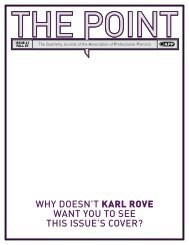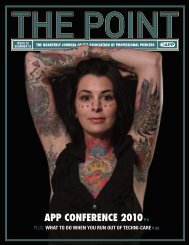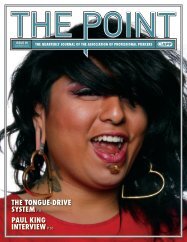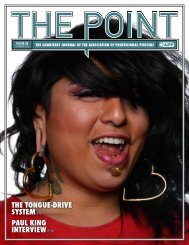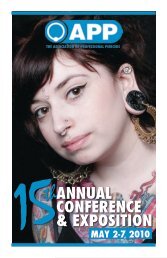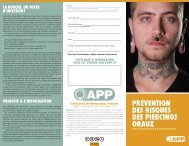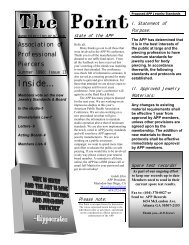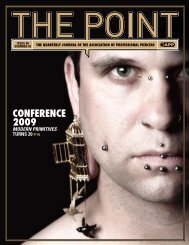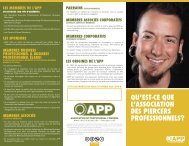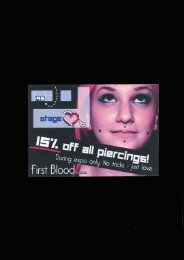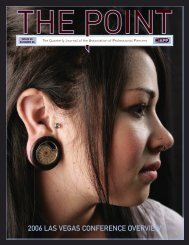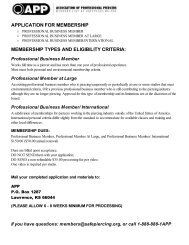Point Journal issue #56 - Association of Professional Piercers
Point Journal issue #56 - Association of Professional Piercers
Point Journal issue #56 - Association of Professional Piercers
You also want an ePaper? Increase the reach of your titles
YUMPU automatically turns print PDFs into web optimized ePapers that Google loves.
Transmogrify<br />
Genne Laakso<br />
Tacoma, WA<br />
Using a post-industrial aesthetic, I<br />
push the boundaries <strong>of</strong> jewelry by<br />
exploring ways to create rituals <strong>of</strong><br />
wearing, marking, and recovery by<br />
making objects that place a physical demand<br />
on the wearer. The culminating pieces <strong>of</strong> the<br />
series knit together contemporary practices<br />
<strong>of</strong> ornament, piercing, and the physical<br />
attributes <strong>of</strong> flesh suspension and relate<br />
to my experiences performing within the<br />
community. My devices leave a temporary or<br />
permanent mark that becomes a secondary<br />
form <strong>of</strong> decoration and a vestige <strong>of</strong> the act.<br />
In 2006 I moved across the country, from<br />
Ohio to Washington, to begin my Masters<br />
in Fine Arts degree focusing on jewelry/<br />
metalsmithing at Central Washington<br />
University. I received my BFA at Kent State<br />
University two years prior. I knew I would<br />
be continuing my undergraduate thesis:<br />
developing devices that marked the body.<br />
A year into my MFA thesis I began my<br />
adventure into body suspension—marking<br />
a huge transition in my life. At this time I<br />
had spent more than ten years researching<br />
the history <strong>of</strong> body modification rituals,<br />
practitioners, and the cultures involved. I<br />
never knew it would lead me to be where I am<br />
today. After experiencing body suspension I<br />
became intrigued with the personal, physical,<br />
and emotional sensations (before, during, and<br />
after); the physical form <strong>of</strong> the body while<br />
suspended; and the marks that are left by the<br />
hooks. During a public performance with a<br />
group based out <strong>of</strong> Michigan, now known<br />
as Escape Suspension, I wore Subjectivity/<br />
Objectivity (Garter IV), a garter I made from<br />
razor blades. This heightened the suspension<br />
experience for me, though my work was<br />
secondary to the public act <strong>of</strong> suspension. I<br />
struggled for months on ways to merge the<br />
physical attributes <strong>of</strong> body suspension with<br />
jewelry. It wasn’t until I gave up on forcing the<br />
ideas that they began to emerge.<br />
In my last year <strong>of</strong> graduate school in<br />
2008/09, Promenading in Elation and<br />
Amalgamation developed out <strong>of</strong> my<br />
experiences and interest in merging jewelry/<br />
sculpture with the physical transformation<br />
<strong>of</strong> flesh suspension. This raised the question:<br />
Was I willing to slowly become physically part<br />
<strong>of</strong> my work in a manner I hadn’t experienced<br />
yet? It seemed only natural to proceed with<br />
these last two devices. Promenading in Elation<br />
and Amalgamation are inspired by methods<br />
<strong>of</strong> pulling the skin with hooks using weights<br />
and tension lines rather than the weight<br />
<strong>of</strong> the body, historic rituals, suspension<br />
practitioners, and artists who have used these<br />
methods (such as Stelarc 1 ).<br />
1. Stelarc, an Australian artist, began to exhibit his notion that “the body is obsolete” by merging flesh suspension and performance art in the 1970s. He performed more<br />
than twenty flesh hook suspensions hanging from a machine in different locations such as over the streets in New York City during rush hour. Stelarc believed that “the<br />
cables were lines <strong>of</strong> tension, which were part <strong>of</strong> the visual design <strong>of</strong> the suspended body, and the stretched skin was a kind <strong>of</strong> gravitational landscape. The skin has<br />
a boundary for the soul for the self and simultaneously a beginning to the world.” Once the technology stretches and pierces the skin, the skin as a barrier is erased.<br />
Source: Paolo Atzori and Kirk Wolford, "Extended-Body: Interview with Stelarc," in The Artist's Body, 184 (New York: Phaidon Press Inc., 2006).<br />
ISSUE 56 THE POINT 13



